The Most Valuable Australian Rare Coins List and Value
Posted onWhile the United States stands as a pioneer in numismatics, boasting a treasure trove of incredibly diverse rare pieces, the global landscape of rare coin collecting extends far beyond its borders. Venturing into international numismatic territory, this piece aims to provide readers with a most valuable rare Australian coins list and value insights, highlighting:
- Noteworthy high-value Australian coins.
- The historical and cultural nuances of these iconic coins.
- Prime online sources for the best quality rare coins.
Watch this insightful video to delve deeper into the world of valuable Australian coins:
Rare valuable Australian coins below $1
While Australian bullion coins often steal the spotlight in discussions about coin collecting, numismatists might be surprised at rare Australian coins’ values.
Rare Australian coins: half penny
Recognized as Australia’s rarest halfpenny and exemplifying the charm of rare old Australian coins, the 1923 halfpenny holds a revered status in Australian numismatics. Made of bronze, the coin’s obverse, designed by Bertram Mackennal, features the effigy of King George V, surrounded by the inscription “GEORGIVS V D.G. BRITT: OMN: REX F.D. IND: IMP:” denoting his titles. On the reverse, it bears the legend “COMMONWEALTH OF AUSTRALIA”, accompanied by the denomination “HALF PENNY” and the year of issue.
The elite numismatic status of the 1923 halfpenny stems from its limited mintage of approximately 15,000, making it one of the best rare Australian coins to look out for. A notable historical mix-up initially attributed the coin to the Sydney Mint due to an error in their Annual Report, which wrongly recorded the striking of 1,113,600 halfpennies in 1923. This led to the misconception that the 1923 Halfpenny was a common coin.
However, meticulous research by curator John Sharples, conducted decades later, clarified that the coin was actually struck at the Melbourne Mint. Sharples’ thorough analysis revealed that the 1,113,600 halfpennies produced at the Sydney Mint were dated 1922, not 1923. This correction solidifies the 1923 halfpenny as Australia’s rarest circulating halfpenny, adding an intriguing layer to its historical narrative.
1923 Halfpenny
- Metal: Bronze
- Year: 1923
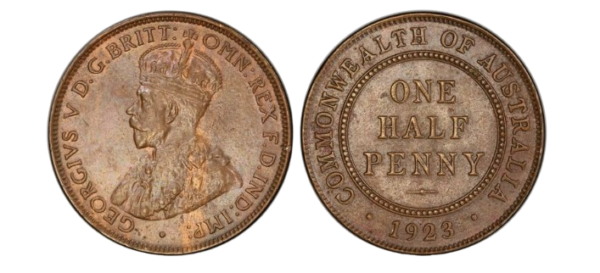
Photo by PCGS
Rare Australian 1 cent coins
The 1968 one cent coin is a rare Australian coin that marks a significant chapter in the nation’s numismatic evolution, symbolizing Australia’s transition to a decimal currency system initiated on February 14, 1966. Before this, Australia used a pounds, shillings, and pence system inherited from its British colonial past. The intricate calculations required for everyday transactions were often cumbersome, leading to the decision to adopt a simplified decimal system that would align the nation’s currency with global standards.
Crafted by Stuart Devlin, this coin is a remarkable piece with a diameter of 17.65 millimeters and a weight of 2.6 grams. Showcasing a feathertail glider, an iconic marsupial, on the reverse and Queen Elizabeth II’s effigy sculpted by Arnold Machin on the obverse, it is renowned for having the lowest mintage in its series.
Adding to its exceptional rarity is the absence of a 1968 mint set release by the Royal Australian Mint, making it one of the most challenging dates to acquire, especially in uncirculated condition. Collectors often seek out this coin as part of their pursuit of rare Australian coins worth money.
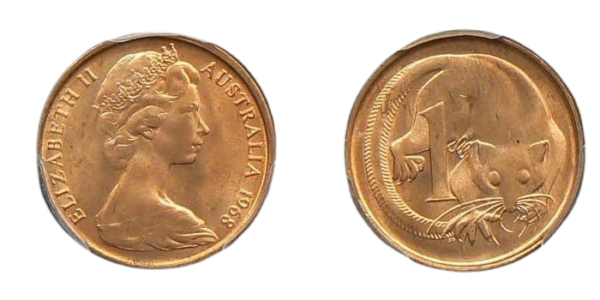
Photo by Drake Sterling
Rare Australian 2 cent coins
The Australian two-cent coin, introduced with the Currency Act 1965, holds a distinctive place in the nation’s coinage. Unlike other denominations, the two cents didn’t directly replace a pre-decimal coin but rather represented a rounded equivalent to 2.4 pence. Notably, the halfpenny, penny, and threepence had no direct equivalent in the new system, setting the two cents apart.
While two-cent coins were minted from 1966 to 1991, the 1981 “NO SD” edition stands out as an exceptional Australian rare coin. A striking piece in copper-nickel, created during a period known for its distinctive coin designs, it features a frilled-neck lizard, an emblematic representation of Australia’s rich biodiversity, on the reverse, designed by Stuart Devlin.
However, despite the coin’s design typically featuring the designer’s initials, “SD,” positioned behind the lizard’s front feet, some issues from 1981 notably lack this distinctive element. Mysteriously echoing anomalies observed in coins from 1968 and 1967, this intriguing deviation contributes to the coin’s allure, raising questions among collectors seeking rare expensive Australian coins about the intricacies of the minting process during that specific period.
1981 2 Cent NO SD
- Metal: Copper
- Year: 1981
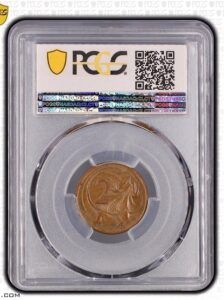
Photo by PCGS
Valuable rare Australian 5 cent coins
From its introduction with decimalization in 1966, replacing the pre-decimal sixpence while maintaining its size and mass, the five-cent coin has endured, today holding the status as the smallest denomination in Australian currency. One of the years that stands out the most in the coin’s long history, however, is 1972, a time when rare Australian coins’ value became particularly notable.
Crafted from nickel, this coin bears an echidna design on the reverse – a hallmark of Australian currency. On the obverse, it showcases Queen Elizabeth II’s effigy, known as the “Second Portrait.”
Though its design is beautiful and considered classic, what sets the 1972 edition apart from other rare 5c Australian coins is its low mintage and historical context. The year 1972 marked a pivotal moment in Australian coinage, due to a shift that occurred in the composition of the coin, transitioning from 75% copper and 25% nickel to pure nickel. Collectors cherish the 1972 edition for its connection to this transition and the evolving nature of Australian currency.
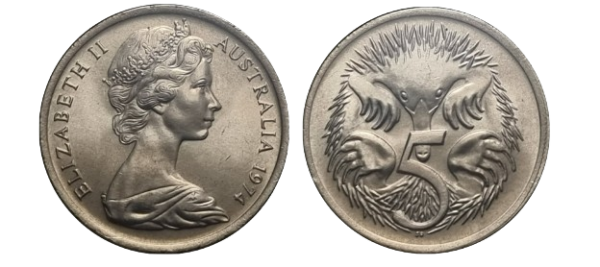
Rare Australian 10 cent coins list
Since its introduction in 1966, the Australian 10-cent coin has generally been characterized by uniformity in design and composition. Its exquisite design featuring the intricate impression of a lyrebird sculpted by Stuart Devlin has endured, remaining a constant source of aesthetic appeal and capturing the essence of Australia’s wildlife throughout the years. For this reason, some collectors might say that rare 10c Australian coins do not offer a particularly lucrative avenue for exploration.
Nevertheless, this notion may not hold entirely true, as certain 10-cent coins, particularly the 2011 issue, deviate from the norm. With an exceptionally low mintage of 1.7 million, the 2011 10-cent coin stands out as a key date for collectors, especially considering its scarcity compared to the average mintage of 45.80 million coins per year for the denomination. Speculation abounds regarding the reasons behind this unusually low mintage, with some enthusiasts suggesting a limited production run or a deliberate effort to create Australian rare coins worth money.
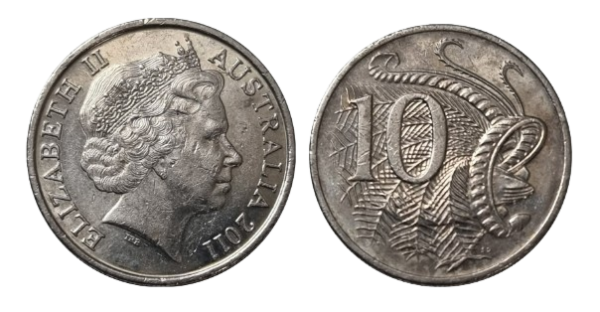
Valuable rare Australian 20 cent coins list
Since its inception, the Australian 20 cent coin has played a significant role as a staple denomination in daily transactions across the country. Among its diverse releases, the 1966 coin carries special importance, signifying the inaugural year of decimalization.
Despite a substantial mintage of 58.2 million, the 1966 20 cent coin is relatively widespread in circulation. However, within this release lies a rare and distinctive variant – the 1966 wavy baseline 20 cent coin, distinguished as one of Australia’s rarest decimal coins issued for circulation, commanding noteworthy value in the domain of Australian rare coin values.
Characterized by a subtle yet discernible wave in the baseline of the “2” on the reverse side, this variant sets itself apart from the standard 20 cent coins of the same year. The wavy baseline anomaly, while seemingly minor, has significant implications for collectors, especially those seeking rare Australian 20c coins. It adds a layer of uniqueness to the coin, making it a sought-after rarity in numismatic circles.
The cause of this design difference remains a topic of debate among experts, adding an element of mystery to the coin’s origin story. The scarcity of well-preserved specimens further elevates the 1966 wavy baseline 20 cent coin’s status as a prized collectible, offering enthusiasts a fascinating glimpse into Australia’s numismatic history and the intriguing anomalies that occasionally emerge within it.
1966 20 Cent Wavy “2”
- Metal: Copper Nickel
- Year: 1966
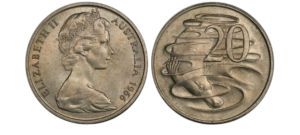
Photo by PCGS
To learn more about this special piece, consult this article’s “Rare Australian coins to look out for” section.
Most wanted valuable rare Australian 50 cent coins
In 1977, the Royal Australian Mint marked the 25th anniversary of Queen Elizabeth II’s accession with a distinctive circulating 50 cent coin. This coin, produced in the millions as part of the silver jubilee celebration, featured a unique design showcasing the Australia coat of arms.
While the sheer quantity may not initially suggest rarity, the narrative takes an intriguing turn with the unanticipated discovery of a limited number of 1977 50 cent coins bearing the non-commemorative Australia coat of arms design from preceding and subsequent years. This unintentional creation, identified as a “mule”, i.e. a coin that is struck with mismatched dies resulting in a combination of obverse and reverse designs that were not originally intended to be paired together, introduces a captivating dimension to the numismatic story of this rare Australian 50 cent coin. Notably, this specific coin, considered a mint error with fewer than 10 known examples, stands as a prized discovery for collectors.
1977 50 Cent Mule
- Metal: Copper Nickel
- Year: 1977
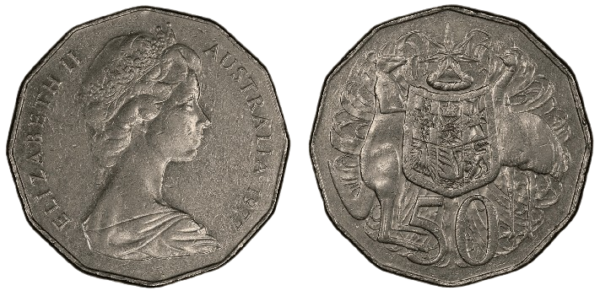
Photo by PCGS
Rare Australian dollar coins
Rare Australian $1 dollar coins list
Introduced in 1984 to replace the $1 note, the Australian $1 coin has become a staple in the country’s currency. Among its various releases over the years, though, some stand out and regularly feature in pieces compiling a list of rare Australian coins. A 2005 $1 coin error coin is a case in point.
The 2005 Australian $1 coin, a part of the revered “Mob of Roos” series, has garnered significant attention due to a distinctive error, transforming it into a highly sought-after collectible. Among the 5.1 million coins minted that year, only a few exhibit a striking off-center design, caused by a misalignment during production. This error, resulting in a rare Australian 1 dollar coin with about 10% or 2-3mm off-center placement, has left a portion of the design truncated, creating a visually captivating variety.
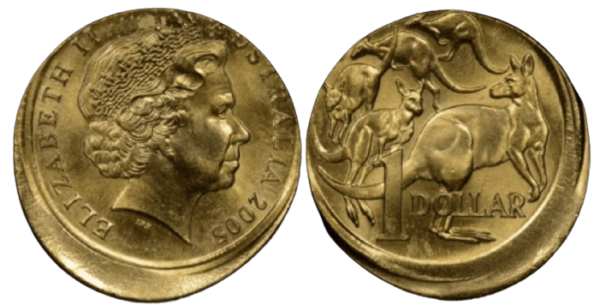
Photo by Finance.Yahoo
Rare $2 Australian coins
The Australian two-dollar coin, introduced in 1988, has undergone various transformations over the years, becoming an integral part of the nation’s currency. In recent years, limited edition rare Australian 2 dollar coins have garnered widespread popularity, reflecting the growing interest in numismatics.
A great illustration of this point is the 2012 Remembrance Day Red Poppy $2 Coin. Issued in two versions – one without a mintmark and the other featuring a ‘C’ mintmark – it holds a special place in collectors’ hearts with its low mintage of just 500,000 units.
Furthermore, the poignant symbolism of the red poppy, a powerful reminder of the sacrifices made by servicemen and women, means this rare $2 Australian coin strongly resonates with both collectors and those appreciative of the historical narratives embedded in currency.
2012-C $2 Remembrance Day Red Poppy
- Metal: Aluminum Bronze
- Year: 2012
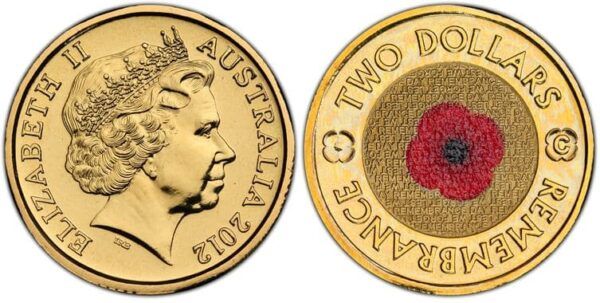
Photo by PCGS
Explore a selection of rarities that extends beyond the most rare Australian coins.
Where to find rare Australian coins for sale
The realm of Australian numismatics is a fascinating and diverse tapestry of rare coins spanning various denominations and historical periods. Collectors who embrace these rare coins often discover that not only do these treasures enhance the aesthetic appeal of their collection, but they also add significant historical and intrinsic value.
To embark on or elevate your numismatic journey, use Blanchard. Connect with Blanchard’s team of experts for valuable insights and guidance on rare and valuable Australian coins and more.
Want to read more? Subscribe to the Blanchard Newsletter and get our tales from the vault, our favorite stories from around the world and the latest tangible assets news delivered to your inbox weekly.







